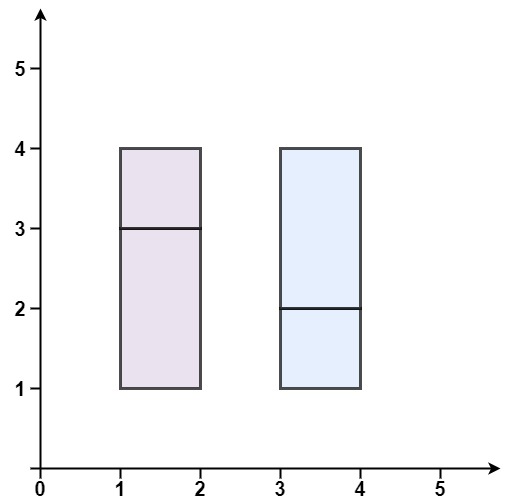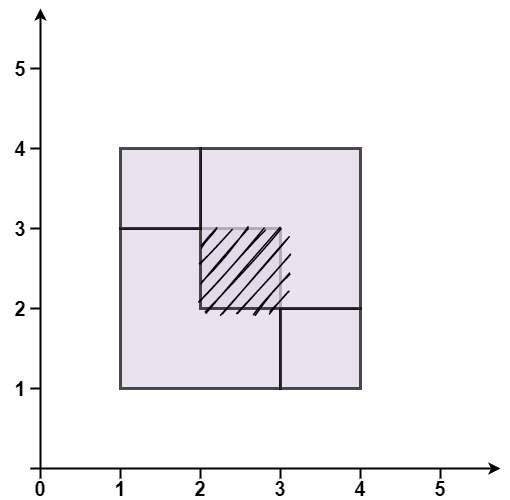LeetCode in Kotlin
391. Perfect Rectangle
Hard
Given an array rectangles where rectangles[i] = [xi, yi, ai, bi] represents an axis-aligned rectangle. The bottom-left point of the rectangle is (xi, yi) and the top-right point of it is (ai, bi).
Return true if all the rectangles together form an exact cover of a rectangular region.
Example 1:

Input: rectangles = [[1,1,3,3],[3,1,4,2],[3,2,4,4],[1,3,2,4],[2,3,3,4]]
Output: true
Explanation: All 5 rectangles together form an exact cover of a rectangular region.
Example 2:

Input: rectangles = [[1,1,2,3],[1,3,2,4],[3,1,4,2],[3,2,4,4]]
Output: false
Explanation: Because there is a gap between the two rectangular regions.
Example 3:

Input: rectangles = [[1,1,3,3],[3,1,4,2],[1,3,2,4],[2,2,4,4]]
Output: false
Explanation: Because two of the rectangles overlap with each other.
Constraints:
1 <= rectangles.length <= 2 * 104rectangles[i].length == 4-105 <= xi, yi, ai, bi <= 105
Solution
import java.util.Objects
class Solution {
fun isRectangleCover(rectangles: Array<IntArray>): Boolean {
val container: MutableSet<Point> = HashSet()
// add each rectangle area to totalArea
var totalArea = 0
// A rectangle has four points, if a point appears twice, it will be deleted it from the set
for (rectangle in rectangles) {
totalArea += (rectangle[2] - rectangle[0]) * (rectangle[3] - rectangle[1])
val p1 = Point(rectangle[0], rectangle[1])
val p2 = Point(rectangle[2], rectangle[1])
val p3 = Point(rectangle[2], rectangle[3])
val p4 = Point(rectangle[0], rectangle[3])
if (container.contains(p1)) {
container.remove(p1)
} else {
container.add(p1)
}
if (container.contains(p2)) {
container.remove(p2)
} else {
container.add(p2)
}
if (container.contains(p3)) {
container.remove(p3)
} else {
container.add(p3)
}
if (container.contains(p4)) {
container.remove(p4)
} else {
container.add(p4)
}
}
// A perfect rectangle must has four points
if (container.size != 4) {
return false
}
// these four points represent the last perfect rectangle, check this rectangle area to the
// totalArea
var minX = Int.MAX_VALUE
var maxX = Int.MIN_VALUE
var minY = Int.MAX_VALUE
var maxY = Int.MIN_VALUE
for (p in container) {
minX = Math.min(minX, p.x)
maxX = Math.max(maxX, p.x)
minY = Math.min(minY, p.y)
maxY = Math.max(maxY, p.y)
}
return totalArea == (maxX - minX) * (maxY - minY)
}
private class Point(val x: Int, val y: Int) {
override fun equals(other: Any?): Boolean {
if (this === other) {
return true
}
if (other == null || javaClass != other.javaClass) {
return false
}
val point = other as Point
return x == point.x && y == point.y
}
override fun hashCode(): Int {
return Objects.hash(x, y)
}
}
}

